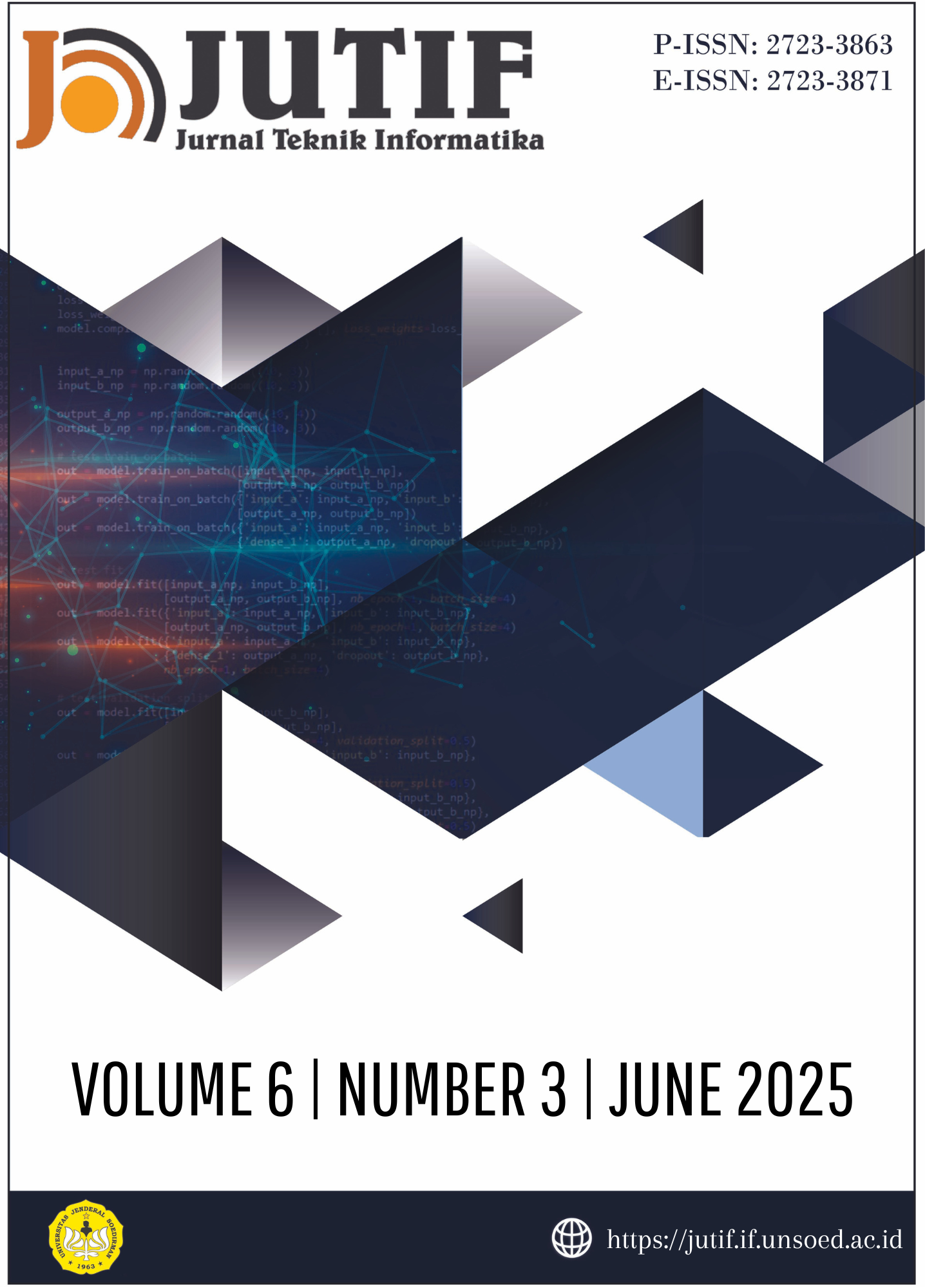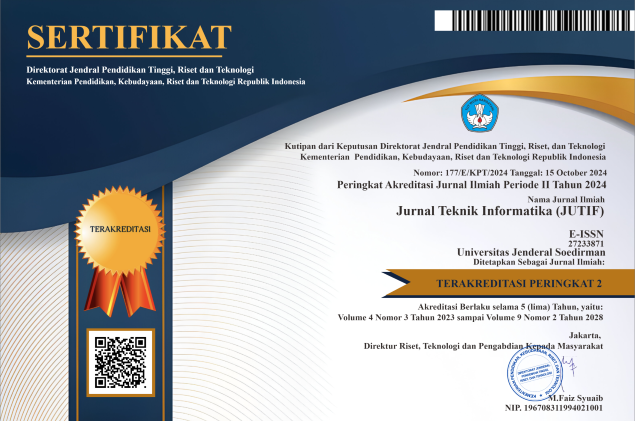Enhancing Monkeypox Skin Lesion Classification With Resnet50v2: The Impact Of Pre-Trained Models From Medical And General Domains
DOI:
https://doi.org/10.52436/1.jutif.2025.6.3.4486Keywords:
Dermatology, HAM10000, ImageNet, Monkeypox, ResNet50v2Abstract
The monkeypox outbreak has emerged as a pressing global health concern, as evidenced by the rising number of cases reported in various countries. This rare zoonotic disease, caused by the Monkeypox virus (MPXV) of the Poxviridae family, is commonly found in Africa. However, since 2022, cases have also spread to various countries, including Indonesia. The dermatological symptoms exhibited by affected individuals vary, with the potential for further transmission through contamination. Early and accurate detection of monkey pox disease is therefore essential for effective treatment. The present study aims to improve the classification of Monkey Pox using the modified Resnet50V2 model, trained using pre-training datasets namely ImageNet and HAM10000, where batch size and learning rate parameters were adjusted. The study achieved high accuracy in distinguishing monkeypox cases, with 98.43% accuracy for Resnet50V2 with pretrained ImageNet and 70.57% accuracy for Resnet50V2 with pretrained HAM10000. Future research will focus on refining these models, exploring hybrid approaches incorporating convolutional neural networks, this advancement contributes to the development of automated early diagnosis tools for monkeypox skin conditions, especially in resource-limited clinical settings where access to dermatology experts is limited.
Downloads
References
“Mpox.” Accessed: Oct. 07, 2024. [Online]. Available: https://www.who.int/news-room/fact-sheets/detail/mpox
L. Jarrell and K. Perryman, “Mpox (monkeypox),” Nurse Pract, vol. 48, no. 4, pp. 13–20, Apr. 2023, doi: 10.1097/01.NPR.0000000000000025.
E. Alakunle, U. Moens, G. Nchinda, and M. I. Okeke, “Monkeypox Virus in Nigeria: Infection Biology, Epidemiology, and Evolution,” Viruses, vol. 12, no. 11, p. 1257, Nov. 2020, doi: 10.3390/v12111257.
M. E. Wilson, J. M. Hughes, A. M. McCollum, and I. K. Damon, “Human monkeypox,” Clinical Infectious Diseases, vol. 58, no. 2, pp. 260–267, Jan. 2014, doi: 10.1093/CID/CIT703.
L. Budiyarto, Ayu Adzani Sabila, and Hafizha Cyndriyani Putri, “Infeksi Cacar Monyet (Monkeypox),” Jurnal Medika Hutama, vol. 4, no. 02 Januari, pp. 3224–3236, Jan. 2023, [Online]. Available: https://jurnalmedikahutama.com/index.php/JMH/article/view/597
I Ketut Suarayasa, Zulkifli, and O. mazmur Kristoper, “Mekanisme Penyebaran Cacar Monyet dan Faktor-Faktor Yang Mempengaruhinya,” SEHATMAS: Jurnal Ilmiah Kesehatan Masyarakat, vol. 2, no. 1, pp. 28–34, Jan. 2023, doi: 10.55123/sehatmas.v2i1.980.
B. K. Titanji, B. Tegomoh, S. Nematollahi, M. Konomos, and P. A. Kulkarni, “Monkeypox: A Contemporary Review for Healthcare Professionals,” Open Forum Infect Dis, vol. 9, 2022, doi: 10.1093/ofid/ofac310.
S. J. R. da Silva, A. Kohl, L. Pena, and K. Pardee, “Clinical and laboratory diagnosis of monkeypox (mpox): Current status and future directions,” iScience, vol. 26, no. 6, p. 106759, Jun. 2023, doi: 10.1016/j.isci.2023.106759.
J. I. Lukito, “Tatalaksana Monkeypox,” Cermin Dunia Kedokteran, vol. 46, no. 8, pp. 504–509, Aug. 2019, doi: 10.55175/cdk.v46i8.423.
E. U. H. Qazi, T. Zia, and A. Almorjan, “Deep Learning-Based Digital Image Forgery Detection System,” Applied Sciences, vol. 12, no. 6, p. 2851, Mar. 2022, doi: 10.3390/app12062851.
M. Rahimzadeh and A. Attar, “A modified deep convolutional neural network for detecting COVID-19 and pneumonia from chest X-ray images based on the concatenation of Xception and ResNet50V2,” Inform Med Unlocked, vol. 19, p. 100360, Jan. 2020, doi: 10.1016/J.IMU.2020.100360.
S. N. Ali et al., “Monkeypox Skin Lesion Detection Using Deep Learning Models: A Feasibility Study,” Oct. 2022. doi: 10.48550/arXiv.2207.03342.
S. N. Ali et al., “A web-based mpox skin lesion detection system using state-of-the-art deep learning models considering racial diversity,” Biomed Signal Process Control, vol. 98, p. 106742, Dec. 2024, doi: 10.1016/J.BSPC.2024.106742.
F. Yasmin et al., “PoxNet22: A Fine-Tuned Model for the Classification of Monkeypox Disease Using Transfer Learning,” IEEE Access, vol. 11, pp. 24053–24076, 2023, doi: 10.1109/ACCESS.2023.3253868.
M. Ahsan, M. R. Uddin, M. Farjana, A. N. Sakib, K. Al Momin, and S. A. Luna, “IMAGE DATA COLLECTION AND IMPLEMENTATION OF DEEP LEARNING-BASED MODEL IN DETECTING MONKEYPOX DISEASE USING MODIFIED VGG16 A PREPRINT,” 2022.
V. H. Sahin, I. Oztel, and G. Yolcu Oztel, “Human Monkeypox Classification from Skin Lesion Images with Deep Pre-trained Network using Mobile Application,” J Med Syst, vol. 46, no. 11, p. 79, Oct. 2022, doi: 10.1007/s10916-022-01863-7.
J. Deng, W. Dong, R. Socher, L.-J. Li, Kai Li, and Li Fei-Fei, “ImageNet: A large-scale hierarchical image database,” in 2009 IEEE Conference on Computer Vision and Pattern Recognition, IEEE, Jun. 2009, pp. 248–255. doi: 10.1109/CVPR.2009.5206848.
L. Studer et al., “A Comprehensive Study of ImageNet Pre-Training for Historical Document Image Analysis,” in 2019 International Conference on Document Analysis and Recognition (ICDAR), IEEE, Sep. 2019, pp. 720–725. doi: 10.1109/ICDAR.2019.00120.
P. Tschandl, C. Rosendahl, and H. Kittler, “Data Descriptor: The HAM10000 dataset, a large collection of multi-source dermatoscopic images of common pigmented skin lesions Background & Summary,” 2018, doi: 10.1038/sdata.2018.161.
Daniel T. Larose and Chantal D. Larose, Discovering Knowledge in Data: An Introduction to Data Mining. John Wiley & Sons, 2014. Accessed: Dec. 29, 2024. [Online]. Available: https://ieeexplore.ieee.org/servlet/opac?bknumber=10066951
K. Jankowsky and U. Schroeders, “Validation and generalizability of machine learning prediction models on attrition in longitudinal studies,” Int J Behav Dev, vol. 46, no. 2, pp. 169–176, Mar. 2022, doi: 10.1177/01650254221075034.
K. He, X. Zhang, S. Ren, and J. Sun, “Deep Residual Learning for Image Recognition,” Dec. 2015.
A. Sorrenti, G. Bellitto, F. P. Salanitri, M. Pennisi, C. Spampinato, and S. Palazzo, “Selective Freezing for Efficient Continual Learning,” in 2023 IEEE/CVF International Conference on Computer Vision Workshops (ICCVW), IEEE, Oct. 2023, pp. 3542–3551. doi: 10.1109/ICCVW60793.2023.00381.
A. Gupta, A. Anand, and Y. Hasija, “Recall-based Machine Learning approach for early detection of Cervical Cancer,” in 2021 6th International Conference for Convergence in Technology (I2CT), IEEE, Apr. 2021, pp. 1–5. doi: 10.1109/I2CT51068.2021.9418099.
F. Zhuang et al., “A Comprehensive Survey on Transfer Learning,” Proceedings of the IEEE, vol. 109, no. 1, pp. 43–76, 2021, doi: 10.1109/JPROC.2020.3004555.
J. Raitoharju, “Convolutional neural networks,” in Deep Learning for Robot Perception and Cognition, Elsevier, 2022, pp. 35–69. doi: 10.1016/B978-0-32-385787-1.00008-7.
R. Llugsi, S. El Yacoubi, A. Fontaine, and P. Lupera, “Comparison between Adam, AdaMax and Adam W optimizers to implement a Weather Forecast based on Neural Networks for the Andean city of Quito,” in 2021 IEEE Fifth Ecuador Technical Chapters Meeting (ETCM), IEEE, Oct. 2021, pp. 1–6. doi: 10.1109/ETCM53643.2021.9590681.
Additional Files
Published
How to Cite
Issue
Section
License
Copyright (c) 2025 Saifulloh Azhar, Abdul Syukur, M. Arief Soeleman, Affandy, Aris Marjuni

This work is licensed under a Creative Commons Attribution 4.0 International License.



























